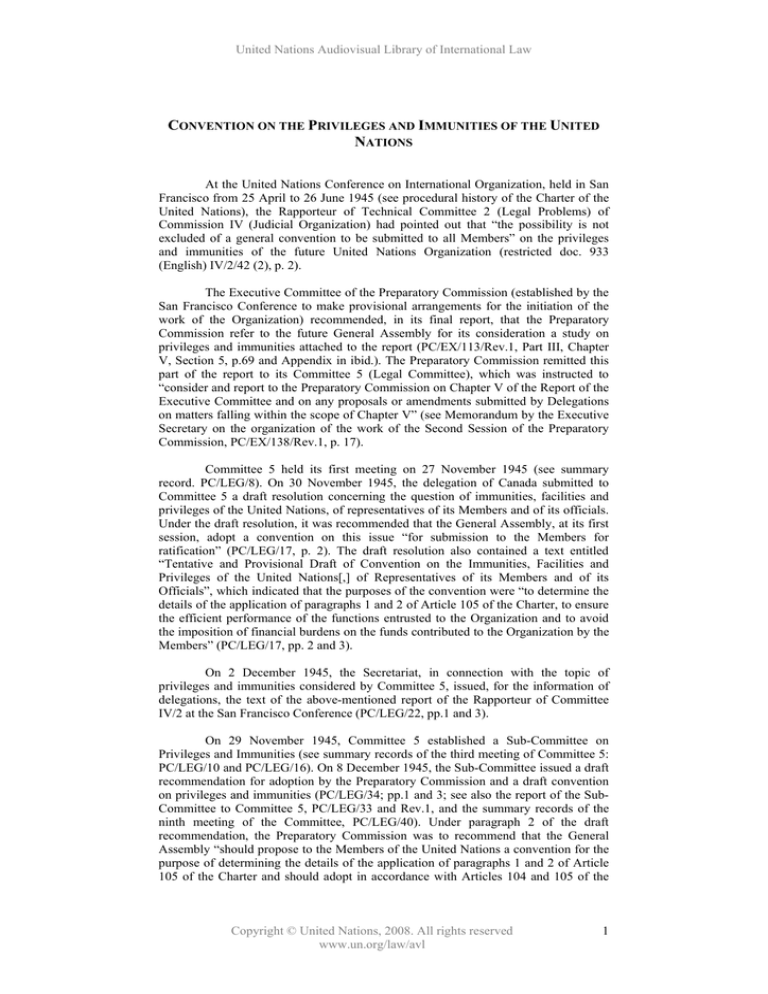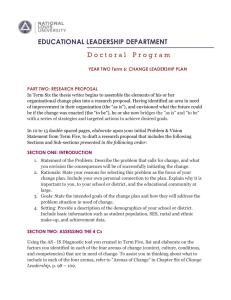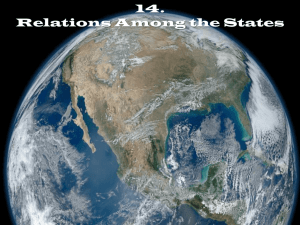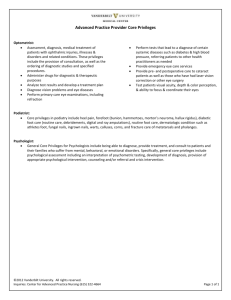
United Nations Audiovisual Library of International Law
CONVENTION ON THE PRIVILEGES AND IMMUNITIES OF THE UNITED
NATIONS
At the United Nations Conference on International Organization, held in San
Francisco from 25 April to 26 June 1945 (see procedural history of the Charter of the
United Nations), the Rapporteur of Technical Committee 2 (Legal Problems) of
Commission IV (Judicial Organization) had pointed out that “the possibility is not
excluded of a general convention to be submitted to all Members” on the privileges
and immunities of the future United Nations Organization (restricted doc. 933
(English) IV/2/42 (2), p. 2).
The Executive Committee of the Preparatory Commission (established by the
San Francisco Conference to make provisional arrangements for the initiation of the
work of the Organization) recommended, in its final report, that the Preparatory
Commission refer to the future General Assembly for its consideration a study on
privileges and immunities attached to the report (PC/EX/113/Rev.1, Part III, Chapter
V, Section 5, p.69 and Appendix in ibid.). The Preparatory Commission remitted this
part of the report to its Committee 5 (Legal Committee), which was instructed to
“consider and report to the Preparatory Commission on Chapter V of the Report of the
Executive Committee and on any proposals or amendments submitted by Delegations
on matters falling within the scope of Chapter V” (see Memorandum by the Executive
Secretary on the organization of the work of the Second Session of the Preparatory
Commission, PC/EX/138/Rev.1, p. 17).
Committee 5 held its first meeting on 27 November 1945 (see summary
record. PC/LEG/8). On 30 November 1945, the delegation of Canada submitted to
Committee 5 a draft resolution concerning the question of immunities, facilities and
privileges of the United Nations, of representatives of its Members and of its officials.
Under the draft resolution, it was recommended that the General Assembly, at its first
session, adopt a convention on this issue “for submission to the Members for
ratification” (PC/LEG/17, p. 2). The draft resolution also contained a text entitled
“Tentative and Provisional Draft of Convention on the Immunities, Facilities and
Privileges of the United Nations[,] of Representatives of its Members and of its
Officials”, which indicated that the purposes of the convention were “to determine the
details of the application of paragraphs 1 and 2 of Article 105 of the Charter, to ensure
the efficient performance of the functions entrusted to the Organization and to avoid
the imposition of financial burdens on the funds contributed to the Organization by the
Members” (PC/LEG/17, pp. 2 and 3).
On 2 December 1945, the Secretariat, in connection with the topic of
privileges and immunities considered by Committee 5, issued, for the information of
delegations, the text of the above-mentioned report of the Rapporteur of Committee
IV/2 at the San Francisco Conference (PC/LEG/22, pp.1 and 3).
On 29 November 1945, Committee 5 established a Sub-Committee on
Privileges and Immunities (see summary records of the third meeting of Committee 5:
PC/LEG/10 and PC/LEG/16). On 8 December 1945, the Sub-Committee issued a draft
recommendation for adoption by the Preparatory Commission and a draft convention
on privileges and immunities (PC/LEG/34; pp.1 and 3; see also the report of the SubCommittee to Committee 5, PC/LEG/33 and Rev.1, and the summary records of the
ninth meeting of the Committee, PC/LEG/40). Under paragraph 2 of the draft
recommendation, the Preparatory Commission was to recommend that the General
Assembly “should propose to the Members of the United Nations a convention for the
purpose of determining the details of the application of paragraphs 1 and 2 of Article
105 of the Charter and should adopt in accordance with Articles 104 and 105 of the
Copyright © United Nations, 2008. All rights reserved
www.un.org/law/avl
1
United Nations Audiovisual Library of International Law
Charter the attached draft convention on privileges and immunities”. On 10 December
1945, the Chairman of the Sub-Committee submitted to Committee 5 his report on the
work of the Sub-Committee, which was followed by a general discussion (see
summary records of the seventh meeting of Committee 5, PC/LEG/35). The draft
recommendation, as amended by the Chinese delegation (PC/LEG/36) and by
suggestions made by members of the Committee, was adopted by Committee 5 on 11
December 1945 (see summary records of the eighth meeting of Committee 5,
PC/LEG/37) and circulated as document PC/LEG/38. On 13 December 1945, the
Chairman of the Sub-Committee proposed additional paragraphs to the draft
convention (PC/LEG/39). Committee 5 held its discussion on the draft convention on
14 and 15 December 1945 (see summary records of the ninth and tenth meetings of
Committee 5, PC/LEG/40 and PC/LEG/41). The Committee thus concluded its work
on 15 December 1945 by unanimously approving the draft convention, although many
delegations made reservations concerning different articles (see PC/LEG/41). At the
same meeting, the Committee, after adopting a deletion proposed by Yugoslavia in
order to ensure that the General Assembly would consider the convention purely as a
working paper, issued the recommendation on privileges and immunities (PC/LEG/42
and Corr. 1).
Following this recommendation, the Preparatory Commission, in its report
dated 23 December 1945, recommended that the General Assembly, at its first session,
“should make recommendations with a view to determining the details of the
application of paragraphs 1 and 2 of Article 105 of the Charter, or propose conventions
to the Members of the United Nations for this purpose” and transmitted “for the
consideration of the General Assembly the attached study on privileges and
immunities and the attached draft convention on privileges and immunities” (PC/20,
Chapter VII, paras. 2 and 3).
At the first session of the General Assembly, the consideration of the report
of Chapter VII of the report of the Preparatory Commission was referred to the Sixth
(Legal) Committee (see the verbatim records of the 16th plenary meeting of the
General Assembly, 19 January 1946). The Sixth Committee held its discussions on the
matter in the first part of the first session of the General Assembly. On 24 January
1946, the Chairman of the Committee proposed that a sub-committee on privileges and
immunities be appointed (see Sixth Committee, Summary records of the sixth meeting,
pp. pp. 14 and 15). Following a brief discussion, the Committee agreed that the terms
of reference of the Sub-Committee would be to make recommendations on whether a
draft convention on privileges and immunities or a series of recommendations on the
topic should be adopted (ibid., p. 15). In its first report (A/C.6/17), the Sub-Committee
recommended that the General Assembly should propose to the Members of the
United Nations a convention in respect of privileges and immunities, to be drafted by
the Sub-Committee; this recommendation was adopted unanimously by the Sixth
Committee on 28 January 1946 (see the summary records of its seventh meeting,
A/C.6/19, p. 16). The Sub-Committee thus submitted a draft of the General
Convention on Privileges and Immunities of the United Nations (see the second report
of the Sub-Committee, in summary records of the Sixth Committee, Annex 3a,
A/C.6/31, p. 45), which the Sixth Committee recommended, with minor modifications,
to the General Assembly for adoption (see Draft Recommendation and Convention on
the Privileges and Immunities of the United Nations, A/C.6/28, and summary records
of the 11th meeting of the Sixth Committee, A/C.6/37, pp. 26-28; see also the decision
contained in ibid., p. 28).
The Convention on the Privileges and Immunities of the United Nations was
approved by the General Assembly on 13 February 1946 by resolution 22 (I) A and
was proposed to every Member of the United Nations for accession. It entered into
force on 17 September 1946.
Copyright © United Nations, 2008. All rights reserved
www.un.org/law/avl
2
United Nations Audiovisual Library of International Law
CONVENTION ON THE PRIVILEGES AND IMMUNITIES OF THE
SPECIALIZED AGENCIES
As indicated above, the issue of the elaboration of a convention on the
privileges and immunities of the United Nations and related issues were considered in
the framework of Committee 5 (Legal Committee) of the Preparatory Commission of
the United Nations.
On 23 December 1945, based on the recommendations of its Committee 5
(PC/LEG/38, p.2, para.5), the Preparatory Commission of the United Nations
recommended to the General Assembly that “the privileges and immunities of
specialized agencies contained in their respective constitutions should be
reconsidered” and that, if necessary, “negotiations should be opened for their coordination in the light of any convention ultimately adopted by the United Nations” on
privileges and immunities (PC/20, Chapter VII, Section 1, p. 60, para. 5). The
Commission pointed out, inter alia, that the privileges and immunities of the United
Nations might be regarded as a maximum within which the specialized agencies
should enjoy such privileges and immunities as the proper fulfilment of their
respective functions might require (ibid.).
On the same day the General Assembly approved the Convention on the
Privileges and Immunities of the United Nations, on 13 February 1946, the Assembly
also adopted resolution 22 (I) D entitled “Resolution on the Co-ordination of the
Privileges and Immunities of the United Nations and the Specialized Agencies”, based
on the recommendation proposed by the Sub-Committee on the Privileges and
Immunities of the United Nations (see A/C.6/31) and adopted by the Sixth Committee
on 8 February 1946 (see A/C.6/34 and A/C.6/38). In that resolution, the Assembly
stated that there were “many advantages in the unification as far as possible of the
privileges and immunities enjoyed by the United Nations and the various specialized
agencies”, and considered that “the privileges and immunities of the United Nations
should be regarded, as a general rule, as a maximum within which the various
specialized agencies should enjoy such privileges and immunities as the appropriate
fulfilment of their respective functions may require”. It thus instructed the SecretaryGeneral “to open negotiations with a view to the re-consideration, in the light both of
the General Convention [on privileges and immunities] adopted by the United Nations
and of the considerations above, of the provisions under which the specialized
agencies at present enjoy privileges and immunities”.
At two preliminary meetings, held at Lake Success on 6 and 7 March 1947,
the Secretary-General consulted the representatives of the specialized agencies on a
single draft convention prepared by the United Nations Secretariat (see Report of the
Secretary-General, “Co-ordination of the Privileges and Immunities of the United
Nations and Specialized Agencies”, A/339, p.279). It was agreed that the problem of
the unification of the privileges and immunities of the United Nations and the
specialized agencies would be greatly facilitated by the adoption of such a single
convention (A/339, pp.278 and 279). This convention would apply without distinction
to all the specialized agencies and would lay down the general privileges and
immunities required by those organizations, while reserving the special privileges
which might be needed because of the particular functions of any individual agency.
Subsequently, the International Labour Organization (ILO), the International Civil
Aviation Organization (ICAO) and the United Nations Educational, Scientific and
Cultural Organization (UNESCO) submitted their comments and suggestions on the
draft convention prepared by the United Nations Secretariat (A/339, p. 280).
On 23 July 1947, at a second meeting of the representatives of the specialized
agencies held at Lake Success, the draft convention was amended in accordance with
Copyright © United Nations, 2008. All rights reserved
www.un.org/law/avl
3
United Nations Audiovisual Library of International Law
the observations and proposals received, adopted and submitted to the General
Assembly under cover of a report of the Secretary-General (A/339, p. 281) issued on
20 August 1947. In his report, the Secretary-General pointed out that the specialized
agencies favoured the convening of a general conference of all States Members of the
various specialized agencies, which the specialized agencies themselves would be
invited to attend in a consultative capacity, so as to enable them to submit any
observations and suggestions that might be useful. The conference would discuss and
adopt the text of a convention which it would propose for accession by the States
Members of the United Nations and by States Members of the specialized agencies
which are not Members of the United Nations (A/339, pp. 279 and 280). It was left for
the Assembly to decide on the procedure to be followed in adopting the convention
(A/339, p. 280).
At the second session of the General Assembly, on 23 September 1947, the
question of the co-ordination of the privileges and immunities of the United Nations
and the specialized agencies was referred to the Sixth Committee (see verbatim record
of the 91st plenary meeting of the General Assembly, A/392, p. 302; see also A/392,
p.11, and A/C.6/134, p.1). On 24 September 1947, the Sixth Committee referred this
question to a sub-committee composed of the representatives of Argentina, Canada,
Cuba, Czechoslovakia, Egypt, India, Norway, Union of Soviet Socialist Republics,
United Kingdom, United States of America and Yugoslavia (see A/C.6/134, p.1, and
A/C.6/136, p.1).
On 29 September 1947, the Sub-Committee on Privileges and Immunities of
the Sixth Committee submitted an interim report (A/C.6/148) to the Sixth Committee
stating that it had unanimously agreed that a single convention applicable to all the
specialized agencies should be drafted. According to this interim report, the
convention “when it had come fully into force, would be regarded as a complete
statement of the privileges and immunities of the Specialized Agencies, apart from any
special agreements concluded with the country in which their seat is established”(
A/C.6/148, p. 2).While the Sub Committee recommended that the General Assembly
should adopt the general part of the convention containing the standard privileges and
immunities in definitive form, it also suggested that the texts of the various annexes
drawn up by the Assembly and adapting the standard clauses to each of the agencies
“might be made recommendations only and might be definitively settled in discussions
held in the conferences or assemblies of the specialized agencies themselves”
(A/C.6/148, p.3). On 2 October 1947, the Sixth Committee approved the interim report
of the Sub-Committee without discussion (see A/C.6/148, p.23).
Thereafter, on 15 November 1947, the Sub-Committee submitted a draft
convention to the Sixth Committee for approval by the General Assembly (A/C.6/191,
p.1). Although in a certain number of cases the privileges granted were narrower in
scope than those of the United Nations, they were modelled on those of the
Convention on Privileges and Immunities of the United Nations (A/C.6/191, para.5,
p.3). The draft convention also contained nine annexes adapting the general provisions
to each of the specialized agencies brought into relationship with the United Nations
(A/C.6/191, para. 5, p. 3, and para. 13, p. 6) — namely, the International Labour
Organization (ILO), the Food and Agriculture Organization of the United Nations
(FAO), the International Civil Aviation Organization (ICAO), the United Nations
Educational, Scientific and Cultural Organization (UNESCO), the International
Monetary Fund (IMF), the International Bank for Reconstruction and Development
(IBRD), the World Health Organization (WHO), the Universal Postal Union (UPU)
and the International Telecommunication Union (ITU) — and provided that a draft
annex, based on the standard clauses, could be recommended by the Economic and
Social Council for any agency later brought into relationship with the United Nations
(A/C.6/191, para. 8, p. 4). The Sub-Committee recommended that the convention
become applicable to each specialized agency when the final text of the relevant annex
had been adopted by the agency in question according to its constitutional procedure
Copyright © United Nations, 2008. All rights reserved
www.un.org/law/avl
4
United Nations Audiovisual Library of International Law
and was received by the Secretary-General of the United Nations (A/C.6/191, paras. 6
and 7, p.3). The Sub-Committee also recommended three draft resolutions for adoption
by the Sixth Committee (A/C.6/191). On 20 November 1947, the Sixth Committee
considered the report of the Sub-Committee (A/C.6/191 and A/C.6/191/Corr.1) and,
following a brief discussion, adopted the report.
On 21 November 1947, the General Assembly considered the report of the
Sixth Committee (A/503) and, by resolution 179 (II), approved the Convention on the
Privileges and Immunities of the Specialized Agencies, which was submitted to the
specialized agencies for acceptance and to every Member of the United Nations and to
every other State Member of one or more of the specialized agencies for accession.
The Convention entered into force on 2 December 1948.
Copyright © United Nations, 2008. All rights reserved
www.un.org/law/avl
5



